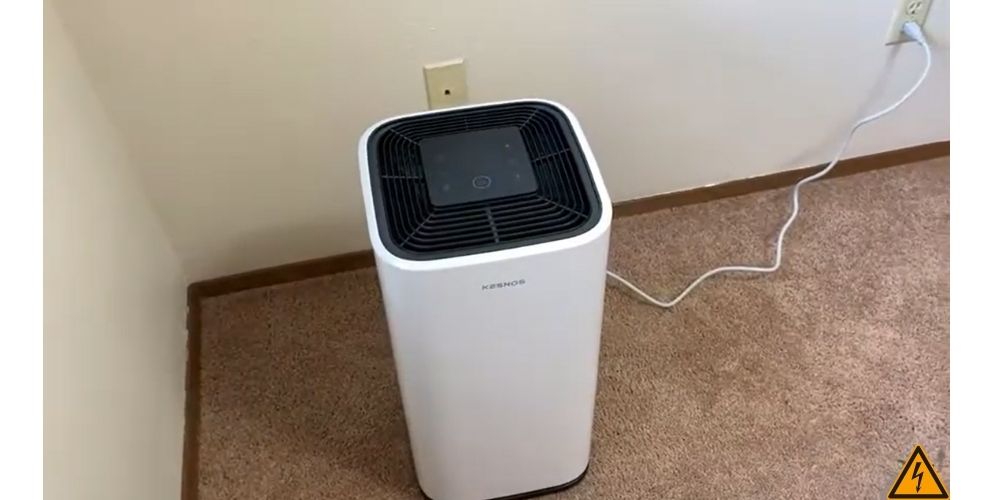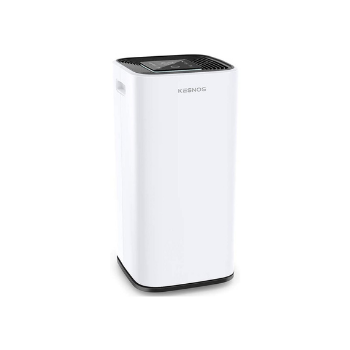How many watts does a 70-pint dehumidifier use?
3 Key Takeaways:
🚀 A 70-pint dehumidifier uses 700W of energy, which is relatively low compared to other household appliances.
🚀 A regular 70-pint dehumidifier will use anywhere between 600W to 800W, and the amps conversion of this is around 3.2A to 7.2A.
🚀 The Kesnos 70-pint dehumidifier is a great option for energy efficiency, with a sleek design, portability, and an energy star label.
A 70-pint dehumidifier uses 700W of energy which is relatively low compared to other household appliances. A 70-pint dehumidifier uses more energy than that used by a computer and less energy than a microwave.
With summer temperatures soaring to a record high, humidity is bound to be on the rise. When there is excess heat in enclosed spaces, it tends to create a lot of moisture.
Additionally, if you like to keep plants indoors, often keep your windows closed, and love to take hot showers, then the chances of increased humidity levels at home are higher. All of these can often contribute to a damp home environment. If this goes unchecked, it can also lead to mold and mildew in the corners of your home.
If you often find water droplets on your windows, constantly feeling very warm in your home despite regularly ventilating it, it’s time to invest in a dehumidifier. A dehumidifier can be easy on the pocket if you want to bring down the humidity and heat indoors.
Read on to learn more about how much energy a dehumidifier consumes compared to other home appliances before buying the most energy-efficient dehumidifier.
How many amps does A 70-pint dehumidifier pull?

A regular 70-pint dehumidifier will use anywhere between 600W to 800W. The amps conversion of this is around 3.2A to 7.2A. This will vary depending on the make and setting of the dehumidifier.
Our pick for the most energy-efficient 70-pint dehumidifier:
Kesnos 70-pint dehumidifier for energy efficiency
With a sleek design, the Kesnos dehumidifier is portable and ergonomically designed. It also has an energy star label. The fan speed can be adjusted for convenience and will not disturb anyone. With just one setting change, it can be adjusted to dry clothes indoors.
Among the various energy-efficient dehumidifiers in the market, the Kesnos dehumidifier is designed for large spaces that measure up to 4,500 sq feet. It can remove up to 70 pints of moisture in a day. It is ideal for basements, homes, offices, bathrooms, laundry rooms, stockrooms, and living rooms.
With intelligent touch control and automatic restart, the digital display makes it easy to check the humidity levels in the room and adjust the settings according to the space and temperature. The restart function kicks in after a power cut and can protect the unit from getting damaged from frequent power outages.
Moreover, the water tank level monitor stops the operation once the tank is full, thus prolonging the lifespan of the dehumidifier. The unit has caster wheels and recessed handles to make portability easy.
The Kesnos dehumidifier comes with two drain options – auto and manual. The auto drain function helps you drain the water continuously without needing to empty the bucket. The manual drain offers the bucket-full indicator to let you know when the bucket is full and needs to be emptied.
Additionally, Kesnos dehumidifiers come with a 30-day money-back, 1-year warranty, and extended warranty. You get more power and a better moisture removal rate.
Which is cheaper to run a dehumidifier or tumble dryer?
The primary function of a tumble dryer is to dry clothes using heat. Whereas a dehumidifier works to extract humidity from the environment, and the dryness is a bonus.
While a dehumidifier uses both cold and hot coils to remove excess moisture, the dryer keeps clothes dry by extracting the water from clothes and essentially steaming them. As a result of this process, dryers tend to release a lot of moisture into the air, which is why you will notice a lot of condensation when you go to laundry rooms without air conditioning.
A tumble dryer usually runs at 3.3 KW/hour, which would be around 11 cents per kilowatt/hour.
If you run a dehumidifier that operates at about 20-30 kilowatt/ hour, it costs 8-12 cents per kilowatt/hour. The energy calculations vary depending on the size of the room, the dehumidifier, and the humidity level.
One big dehumidifier or two small dehumidifiers?
Although smaller dehumidifiers may have a lower electricity cost given their size, it’s important to note that they will need to run for an extended period to remove the same amount of moisture as a large dehumidifier which will remove moisture in a shorter period.
So while it may draw less power per unit than a large capacity, having two small dehumidifiers for the same space may not be economical. However, there are many energy factors to consider other than area.
Besides size, one might also have to consider the placement and noise levels of the dehumidifier. Some people are easily disturbed by the slightest sounds, so having a large one may be a hassle for them. In this case, two quiet ones may do the trick.
The key thing to remember to save on an electric bill is to buy a size proportional to the room, clean it regularly, and run it in its optimum setting to ensure that it is one of the energy-efficient dehumidifiers.
FAQ Section
1. How many watts is a 50-pint dehumidifier?
A 50-pint dehumidifier would use around 550 watts, roughly 4.7 amps of energy drawn. The electricity cost would be low as it would be energy efficient.
2. How many kWh does a dehumidifier use per day?
The amount of energy used depends on a range of factors like the humidity levels and the room size. If there is high humidity in a large room, you will have to run a dehumidifier for a longer time.
However, sometimes when a certain moisture level is reached, it will automatically switch off and consume less energy. The calculations are based on assessments done over 24 hours and tested across various dehumidifiers.
3. Does Frigidaire make a 70-pint dehumidifier?
Unfortunately, Frigidaire no longer makes 70-pint dehumidifiers. Instead, they make 50-pint dehumidifiers now.
4. How often do you have to empty a 70-pint dehumidifier?
If a dehumidifier has been operating continuously, you must empty it 3 to 4 times per 24-hour period. However, if there is not a lot of humidity and the dehumidifier has automatically turned off, then the number of times the tank needs to be emptied will reduce.
A smaller tank that, for instance, only holds 12 pints of water of 50 pints will need to be changed more frequently.
5. Does a dehumidifier need a dedicated circuit?
Usually, a dehumidifier that pulls less than eight amps does not require a dedicated circuit. Many homes often already have GFCI or a Ground Fault Circuit Interrupter.
These are set up to monitor the balance of electricity moving through a circuit and ensure that power doesn’t go where it shouldn’t.
If it does, the GFCI cuts off the supply to prevent an outage or any hazards. It’s a good idea to check if your building or home already has a GFCI installed for other large appliances like a furnace, freezer, dryer, washer, and garbage disposal are some examples that require one.
5. Does a dehumidifier reduce electric bills?
Using fans and AC to combat excess heat and humidity during the summertime can often make a big dent in the monthly cost of electricity. When moisture levels rise in the air, your body cannot release heat, thus making you feel hotter than usual.
Since your body cannot cool off naturally and quickly, you will need to run a fan and AC for a longer time.
An easy way to combat moisture and humidity is to invest in a good-quality dehumidifier.
Once you use a dehumidifier, you will immediately notice a difference in the temperatures at home. Your house will start to feel a lot cooler, and you won’t need to turn on the AC or fan often, reducing your utility bills significantly.
6. What can you use instead of a dehumidifier?
There are many DIY alternatives to using a dehumidifier, like keeping your windows open more often, drying your clothes outside, and keeping plants outdoors instead of indoors. However, in colder parts, this may not be easy.
You could also try using a space heater or indoor fans, but these have limited range and need to be monitored, or they can raise a high utility bill. There is no single appliance alternative to a dehumidifier. You can try a combination of strategies mentioned above to combat humidity if a dehumidifier is currently not in your budget.
Wrapping Up
As you’ve seen, there are many aspects to consider when seeking the most energy-efficient dehumidifier. From considering the square footage of an area to finding a dedicated circuit, one needs to consider these factors before making an intelligent buying decision.
However, an easy way to judge if your home needs a dehumidifier is to weigh the cost of existing appliances against your desired outcome. For instance, if you want to cool down your home quicker and have a high utility budget, then an AC might seem like a good option.
If you are living in a cold place and would like to dry your clothes indoors often and humidity is not your main concern, then a dryer might be a good option.
On the other hand, a dehumidifier is a great option if you are concerned about issues like excess humidity or have existing issues like mold, mildew, and damp walls from water damage. A dehumidifier can occasionally double as a dryer. While it may not blast high heat in the same way that a dryer does, it will keep your room and clothes dry at an economical price.
We hope our review alleviates some confusion around a dehumidifier’s energy efficiency.

About The Author
Olivia — a self-confessed air quality addict — is a home climate enthusiast, fresh air advocate, and someone with deep personal experience and knowledge about mold extermination. Her work was mentioned in countless notable humidity publications. Previously she was an editor at Mold Remediation.
